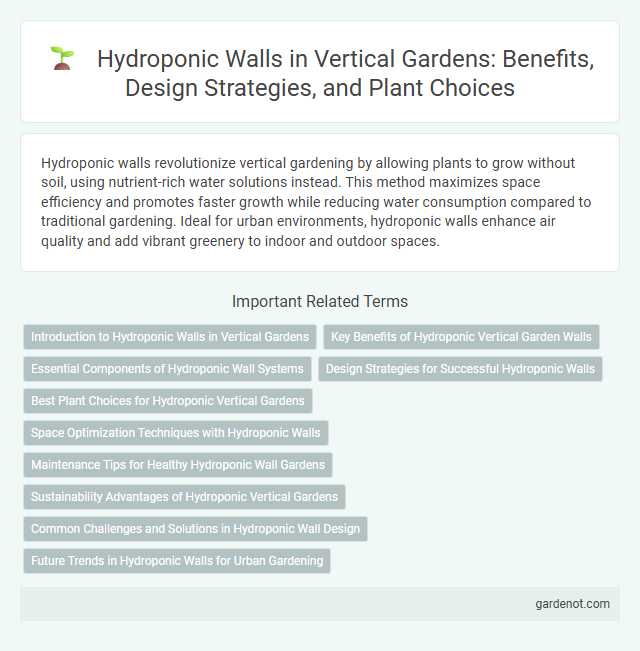Hydroponic walls revolutionize vertical gardening by allowing plants to grow without soil, using nutrient-rich water solutions instead. This method maximizes space efficiency and promotes faster growth while reducing water consumption compared to traditional gardening. Ideal for urban environments, hydroponic walls enhance air quality and add vibrant greenery to indoor and outdoor spaces.
Introduction to Hydroponic Walls in Vertical Gardens
Hydroponic walls in vertical gardens use nutrient-rich water solutions to grow plants without soil, maximizing space efficiency and promoting sustainable urban greening. These systems enable precise control over water, nutrients, and light, enhancing plant growth and reducing resource consumption compared to traditional soil-based methods. Commonly integrated in residential and commercial buildings, hydroponic walls contribute to air purification, thermal insulation, and aesthetic improvement.
Key Benefits of Hydroponic Vertical Garden Walls
Hydroponic vertical garden walls maximize space efficiency by enabling soil-free plant growth on vertical surfaces, making them ideal for urban environments. These systems enhance water conservation by recirculating nutrient-rich solutions, reducing water usage by up to 90% compared to traditional gardening. Additionally, hydroponic walls improve air quality and indoor aesthetics while promoting faster plant growth through controlled nutrient delivery.
Essential Components of Hydroponic Wall Systems
Hydroponic wall systems require key components such as a nutrient delivery system, growth medium, support structure, and water circulation mechanism to ensure optimal plant growth. The nutrient delivery system typically involves a reservoir, pump, and tubing that distribute a balanced, water-soluble nutrient solution directly to plant roots without soil. Essential sensors and control units monitor pH, nutrient concentration, and moisture levels to maintain a stable environment for efficient hydroponic cultivation.
Design Strategies for Successful Hydroponic Walls
Effective hydroponic wall design integrates nutrient film technique (NFT) or aeroponic systems to ensure optimal water and nutrient circulation for plant roots, maximizing growth and minimizing resource waste. Selection of lightweight, durable materials such as PVC and corrosion-resistant metals supports structural integrity and ease of maintenance in vertical installations. Incorporating automated irrigation and lighting controls tailored to plant species enhances growth precision, promoting sustainability and increasing yield in hydroponic wall gardens.
Best Plant Choices for Hydroponic Vertical Gardens
Lettuce, spinach, and herbs like basil, mint, and cilantro thrive in hydroponic vertical gardens due to their fast growth and adaptable root systems. Strawberries and certain varieties of peppers also perform well, benefiting from consistent nutrient delivery in the hydroponic setup. Choosing plants with shallow roots and moderate water requirements ensures optimal growth and maintenance efficiency in hydroponic vertical garden walls.
Space Optimization Techniques with Hydroponic Walls
Hydroponic walls maximize vertical space utilization by enabling dense planting without soil, making them ideal for urban environments with limited square footage. These systems use nutrient-rich water circulation, reducing the need for traditional gardening tools and allowing for efficient water and nutrient delivery directly to plant roots. Advanced designs incorporate modular panels and automated irrigation, further enhancing spatial efficiency and maintenance ease in compact indoor or outdoor areas.
Maintenance Tips for Healthy Hydroponic Wall Gardens
Regularly monitor nutrient levels and pH balance to ensure optimal growth conditions for hydroponic wall gardens. Clean water reservoirs and tubing to prevent algae buildup and root diseases, maintaining a healthy root environment. Inspect plants frequently for pests and remove dead leaves promptly to support vigorous, thriving vertical green walls.
Sustainability Advantages of Hydroponic Vertical Gardens
Hydroponic vertical gardens optimize water usage by recycling nutrient solutions, reducing consumption by up to 90% compared to traditional soil cultivation. These systems eliminate the need for pesticides and herbicides, promoting chemical-free urban agriculture and enhancing local air quality. Their compact design maximizes green space in urban environments, contributing to energy savings and reducing the urban heat island effect.
Common Challenges and Solutions in Hydroponic Wall Design
Hydroponic wall systems often face challenges such as nutrient imbalances, water distribution inefficiencies, and root diseases, which can hinder plant growth and overall system performance. Solutions include implementing automated nutrient dosing systems, designing efficient drip irrigation networks for uniform water flow, and incorporating UV sterilization or beneficial microbes to prevent pathogen build-up. Proper selection of plant species and regular system maintenance further enhance the resilience and productivity of hydroponic vertical gardens.
Future Trends in Hydroponic Walls for Urban Gardening
Hydroponic walls are revolutionizing urban gardening by enabling soil-free cultivation, optimizing space, and improving plant growth rates through precise nutrient delivery systems. Future trends include integrating smart sensors and IoT technology to monitor plant health and automate watering cycles, enhancing efficiency and sustainability. Advancements in LED lighting and renewable energy integration are expected to further boost productivity and support year-round urban food production.
Hydroponic wall Infographic

 gardenot.com
gardenot.com